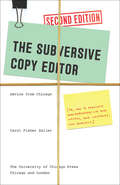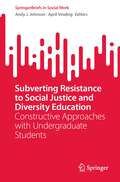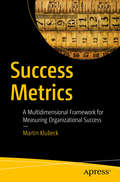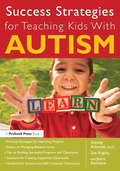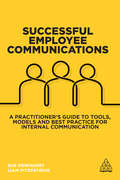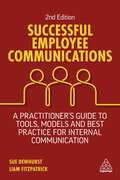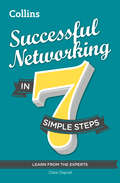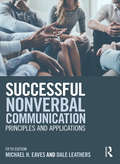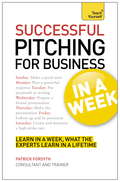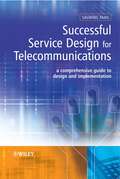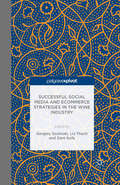- Table View
- List View
Subspace Methods for System Identification (Communications and Control Engineering)
by Tohru KatayamaAn in-depth introduction to subspace methods for system identification in discrete-time linear systems thoroughly augmented with advanced and novel results, this text is structured into three parts. Part I deals with the mathematical preliminaries: numerical linear algebra; system theory; stochastic processes; and Kalman filtering. Part II explains realization theory as applied to subspace identification. Stochastic realization results based on spectral factorization and Riccati equations, and on canonical correlation analysis for stationary processes are included. Part III demonstrates the closed-loop application of subspace identification methods. Subspace Methods for System Identification is an excellent reference for researchers and a useful text for tutors and graduate students involved in control and signal processing courses. It can be used for self-study and will be of interest to applied scientists or engineers wishing to use advanced methods in modeling and identification of complex systems.
Substrate Integrated Suspended Line Antenna and Arrays (Modern Antenna)
by Kaixue Ma Ningning Yan Yu LuoThis book delves deeply into the substrate integrated suspended line antenna technologies and evaluates its potential to replace conventional three-dimensional (3D) metal-based antennas. Over the years, studies on substrate integrated suspended line antennas have captivated engineers and scientists from the antennas and related engineering fields, all aiming to achieve low-cost and low-loss characteristics. The book establishes a fundamental framework for this topic, while emphasizing the importance of substrate integrated suspended line antennas in the wireless communication and radar systems. It is designed for undergraduate and graduate students who are interested in antenna technology, researchers investigating substrate integrated technology, and antenna engineers working on low-cost and low-loss antennas and arrays.
Substrate Noise Coupling in RFICs (Analog Circuits and Signal Processing)
by Ahmed Helmy Mohammed IsmailThe book reports modeling and simulation techniques for substrate noise coupling effects in RFICs and introduces isolation structures and design guides to mitigate such effects with the ultimate goal of enhancing the yield of RF and mixed signal SoCs. The book further reports silicon measurements, and new test and noise isolation structures. To the authors’ knowledge, this is the first title devoted to the topic of substrate noise coupling in RFICs as part of a large SoC.
The Subversive Copy Editor, Second Edition: Advice from Chicago (or, How to Negotiate Good Relationships with Your Writers, Your Colleagues, and Yourself) (Chicago Guides to Writing, Editing, and Publishing)
by Carol Fisher SallerLongtime manuscript editor and Chicago Manual of Style guru Carol Fisher Saller has negotiated many a standoff between a writer and editor refusing to compromise on the “rights” and “wrongs” of prose styling. Saller realized that when these sides squared off, it was often the reader who lost. In her search for practical strategies for keeping the peace, The Subversive Copy Editor was born. Saller’s ideas struck a chord, and the little book with big advice quickly became a must-have reference for copy editors everywhere. In this second edition, Saller adds new chapters, on the dangers of allegiance to outdated grammar and style rules and on ways to stay current in language and technology. She expands her advice for writers on formatting manuscripts for publication, on self-editing, and on how not to be “difficult.” Saller’s own gaffes provide firsthand (and sometimes humorous) examples of exactly what not to do. The revised content reflects today’s publishing practices while retaining the self-deprecating tone and sharp humor that helped make the first edition so popular. Saller maintains that through carefulness, transparency, and flexibility, editors can build trust and cooperation with writers. The Subversive Copy Editor brings a refreshingly levelheaded approach to the classic battle between writers and editors. This sage advice will prove useful and entertaining to anyone charged with the sometimes perilous task of improving the writing of others.
The Subversive Copy Editor, Second Edition: Advice from Chicago (or, How to Negotiate Good Relationships with Your Writers, Your Colleagues, and Yourself) (Chicago Guides to Writing, Editing, and Publishing)
by Carol Fisher SallerLongtime manuscript editor and Chicago Manual of Style guru Carol Fisher Saller has negotiated many a standoff between a writer and editor refusing to compromise on the “rights” and “wrongs” of prose styling. Saller realized that when these sides squared off, it was often the reader who lost. In her search for practical strategies for keeping the peace, The Subversive Copy Editor was born. Saller’s ideas struck a chord, and the little book with big advice quickly became a must-have reference for copy editors everywhere. In this second edition, Saller adds new chapters, on the dangers of allegiance to outdated grammar and style rules and on ways to stay current in language and technology. She expands her advice for writers on formatting manuscripts for publication, on self-editing, and on how not to be “difficult.” Saller’s own gaffes provide firsthand (and sometimes humorous) examples of exactly what not to do. The revised content reflects today’s publishing practices while retaining the self-deprecating tone and sharp humor that helped make the first edition so popular. Saller maintains that through carefulness, transparency, and flexibility, editors can build trust and cooperation with writers. The Subversive Copy Editor brings a refreshingly levelheaded approach to the classic battle between writers and editors. This sage advice will prove useful and entertaining to anyone charged with the sometimes perilous task of improving the writing of others.
The Subversive Copy Editor, Second Edition: Advice from Chicago (or, How to Negotiate Good Relationships with Your Writers, Your Colleagues, and Yourself) (Chicago Guides to Writing, Editing, and Publishing)
by Carol Fisher SallerLongtime manuscript editor and Chicago Manual of Style guru Carol Fisher Saller has negotiated many a standoff between a writer and editor refusing to compromise on the “rights” and “wrongs” of prose styling. Saller realized that when these sides squared off, it was often the reader who lost. In her search for practical strategies for keeping the peace, The Subversive Copy Editor was born. Saller’s ideas struck a chord, and the little book with big advice quickly became a must-have reference for copy editors everywhere. In this second edition, Saller adds new chapters, on the dangers of allegiance to outdated grammar and style rules and on ways to stay current in language and technology. She expands her advice for writers on formatting manuscripts for publication, on self-editing, and on how not to be “difficult.” Saller’s own gaffes provide firsthand (and sometimes humorous) examples of exactly what not to do. The revised content reflects today’s publishing practices while retaining the self-deprecating tone and sharp humor that helped make the first edition so popular. Saller maintains that through carefulness, transparency, and flexibility, editors can build trust and cooperation with writers. The Subversive Copy Editor brings a refreshingly levelheaded approach to the classic battle between writers and editors. This sage advice will prove useful and entertaining to anyone charged with the sometimes perilous task of improving the writing of others.
The Subversive Copy Editor, Second Edition: Advice from Chicago (or, How to Negotiate Good Relationships with Your Writers, Your Colleagues, and Yourself) (Chicago Guides to Writing, Editing, and Publishing)
by Carol Fisher SallerLongtime manuscript editor and Chicago Manual of Style guru Carol Fisher Saller has negotiated many a standoff between a writer and editor refusing to compromise on the “rights” and “wrongs” of prose styling. Saller realized that when these sides squared off, it was often the reader who lost. In her search for practical strategies for keeping the peace, The Subversive Copy Editor was born. Saller’s ideas struck a chord, and the little book with big advice quickly became a must-have reference for copy editors everywhere. In this second edition, Saller adds new chapters, on the dangers of allegiance to outdated grammar and style rules and on ways to stay current in language and technology. She expands her advice for writers on formatting manuscripts for publication, on self-editing, and on how not to be “difficult.” Saller’s own gaffes provide firsthand (and sometimes humorous) examples of exactly what not to do. The revised content reflects today’s publishing practices while retaining the self-deprecating tone and sharp humor that helped make the first edition so popular. Saller maintains that through carefulness, transparency, and flexibility, editors can build trust and cooperation with writers. The Subversive Copy Editor brings a refreshingly levelheaded approach to the classic battle between writers and editors. This sage advice will prove useful and entertaining to anyone charged with the sometimes perilous task of improving the writing of others.
The Subversive Copy Editor, Second Edition: Advice from Chicago (or, How to Negotiate Good Relationships with Your Writers, Your Colleagues, and Yourself) (Chicago Guides to Writing, Editing, and Publishing)
by Carol Fisher SallerLongtime manuscript editor and Chicago Manual of Style guru Carol Fisher Saller has negotiated many a standoff between a writer and editor refusing to compromise on the “rights” and “wrongs” of prose styling. Saller realized that when these sides squared off, it was often the reader who lost. In her search for practical strategies for keeping the peace, The Subversive Copy Editor was born. Saller’s ideas struck a chord, and the little book with big advice quickly became a must-have reference for copy editors everywhere. In this second edition, Saller adds new chapters, on the dangers of allegiance to outdated grammar and style rules and on ways to stay current in language and technology. She expands her advice for writers on formatting manuscripts for publication, on self-editing, and on how not to be “difficult.” Saller’s own gaffes provide firsthand (and sometimes humorous) examples of exactly what not to do. The revised content reflects today’s publishing practices while retaining the self-deprecating tone and sharp humor that helped make the first edition so popular. Saller maintains that through carefulness, transparency, and flexibility, editors can build trust and cooperation with writers. The Subversive Copy Editor brings a refreshingly levelheaded approach to the classic battle between writers and editors. This sage advice will prove useful and entertaining to anyone charged with the sometimes perilous task of improving the writing of others.
The Subversive Copy Editor, Second Edition: Advice from Chicago (or, How to Negotiate Good Relationships with Your Writers, Your Colleagues, and Yourself) (Chicago Guides to Writing, Editing, and Publishing)
by Carol Fisher SallerLongtime manuscript editor and Chicago Manual of Style guru Carol Fisher Saller has negotiated many a standoff between a writer and editor refusing to compromise on the “rights” and “wrongs” of prose styling. Saller realized that when these sides squared off, it was often the reader who lost. In her search for practical strategies for keeping the peace, The Subversive Copy Editor was born. Saller’s ideas struck a chord, and the little book with big advice quickly became a must-have reference for copy editors everywhere. In this second edition, Saller adds new chapters, on the dangers of allegiance to outdated grammar and style rules and on ways to stay current in language and technology. She expands her advice for writers on formatting manuscripts for publication, on self-editing, and on how not to be “difficult.” Saller’s own gaffes provide firsthand (and sometimes humorous) examples of exactly what not to do. The revised content reflects today’s publishing practices while retaining the self-deprecating tone and sharp humor that helped make the first edition so popular. Saller maintains that through carefulness, transparency, and flexibility, editors can build trust and cooperation with writers. The Subversive Copy Editor brings a refreshingly levelheaded approach to the classic battle between writers and editors. This sage advice will prove useful and entertaining to anyone charged with the sometimes perilous task of improving the writing of others.
Subverting Resistance to Social Justice and Diversity Education: Constructive Approaches with Undergraduate Students (SpringerBriefs in Social Work)
by Andy J. Johnson April VindingThis compact book is constructed using psychological theory and research to empower university faculty to facilitate student engagement and address student resistance to diversity and social justice education more effectively. University faculty teaching diversity and social justice have traditionally encountered various forms of student resistance. Recent cultural trends of political opposition to teaching critical race theory and other forms of increased polarization and scapegoating with decreased levels of social tolerance have exacerbated challenges in promoting student engagement in diversity and social justice education in universities and colleges. In contrast to traditional models that tend to be confrontational in addressing student biases, the new Moving Towards Social Justice (MTSJ), Relational Partnership Development Model (RPDM) and process theoretical models seek to build on appropriate pre-existing strengths, interests, values, and the developmental readiness of students who might otherwise oppose learning about the contexts, lives, and predicaments of marginalized persons living in various intersections of gender, race, ethnicity, national origin, immigration status, sexual orientation, gender identity and ability/disability status. Emphasis is placed on the development of professional and life skills, such as wisdom and intercultural competence, which provide incentives and remove barriers to learning about social justice and diversity. Project-based learning approaches grounded in a developmental framework to foster the thriving and well-being of diverse students, collaborative partners in the community, and diverse persons served by the community partners are emphasized. The role of empirical assessment, feedback, and program refinement over time is also delineated within the models.Subverting Resistance to Social Justice and Diversity Education: Constructive Approaches with Undergraduate Students is an indispensable and timely resource for university and college instructors who teach courses or have significant portions of a class that involve education around social justice, diversity, and intersectionality issues, such as cross-cultural psychology, multicultural psychology, social work, sociology, intercultural communication, and counseling or clinical practice with individuals or families from diverse social locations. University officers of diversity, faculty development providers, and other administrators interested in empowering university faculty to increase student engagement in social justice and diversity education also would find the book a useful reference.
Success in Six Cups of Coffee: How Smart Networking Conquers Hidden Obstacles
by P. BethencourtCan it be that in order to reach the investor you need for your new venture, or to find the employer who will give you the chance of a lifetime, you only need to have six cups of coffee? Research tells us there is an average of six intermediate people that form an invisible chain between you and the person who will help you succeed.
Success Metrics: A Multidimensional Framework for Measuring Organizational Success
by Martin KlubeckLearn how to measure success at the individual and organizational levels. By measuring success in multiple dimensions using multivariate methods you will be able to determine what works and what doesn’t. The key is to measure and promote progress in terms of organizational vision, mission, and overarching goals.Business leaders too often succumb to the working assumption that they only have to show shareholders and boards of trustees that they are turning a profit—the higher the profit, the more successful their stewardship of the company. Wrong! To truly thrive and endure, all organizations—corporate, government, small, large, nonprofit, or startup—need to define and pursue the underlying purpose for their existence.To measure success, leaders today are missing a key meta-analytic in their toolbox. In this book, metrics consultant Martin Klubeck provides it to them. Success Metrics steps you through the process of identifying and combining the right measures to gauge, narrate, and guide your organization's progress toward true success. All organizations have a common goal to be successful. All leaders want to make data-informed decisions and use measures to improve processes, communicate progress, and gain support. The problem is that proxy or partial measures don’t measure overall success and can be misleading. They measure performance parameters, progress on a specific task, customer feedback, and other piecemeal indices—which taken separately fail to describe an organization’s progress toward overall success.The author's integrated measures of success can be used to communicate organizational progress to stakeholders, shareholders, boards of trustees, corporate leaders, the workforce, and the customer base and thereby galvanize broad commitment to organizational success. Klubeck shows how his principles and methods of measuring overall success can be applied at all levels: individual, team, group, department, division, and organization.What You Will Learn:Understand why you should measure success instead of performanceUnderstand what to measure and what not to measureIntegrate the measures of success to tell a complete storyShare measures of success with different audiencesWho This Book Is ForOrganizational leaders at all levels from the executive suite to middle management, analysts and consultants who are tasked with designing metrics programs for organizations, individuals interested in adapting the author's framework to measure overall personal success in multiple dimensions
Success Strategies for Teaching Kids With Autism
by Wendy Ashcroft Sue Argiro Joyce KeohaneAlthough an abundance of research exists on working with students with autism, teachers need the practical strategies in Success Strategies for Teaching Kids With Autism to build successful programs and services for kids with autism.The authors, seasoned classroom teachers and consultants for a large public school autism support program, look at ways teachers can apply best practices for teaching special needs students. They offer field-tested ideas for teachers to implement, covering topics such as managing difficult behaviors, teaching social skills, addressing communication difficulties, creating schedules, and organizing the classroom.The book includes a detailed section on using applied behavior analysis, providing practical examples for teachers to employ in their own classrooms in order to modify student behaviors and increase learning. Including teacher-friendly overviews of the educational needs of students with autism and ideal teaching methods, the book also provides reproducible materials and photographs that show the strategies in action.
Success Strategies for Teaching Kids With Autism
by Wendy Ashcroft Sue Argiro Joyce KeohaneAlthough an abundance of research exists on working with students with autism, teachers need the practical strategies in Success Strategies for Teaching Kids With Autism to build successful programs and services for kids with autism.The authors, seasoned classroom teachers and consultants for a large public school autism support program, look at ways teachers can apply best practices for teaching special needs students. They offer field-tested ideas for teachers to implement, covering topics such as managing difficult behaviors, teaching social skills, addressing communication difficulties, creating schedules, and organizing the classroom.The book includes a detailed section on using applied behavior analysis, providing practical examples for teachers to employ in their own classrooms in order to modify student behaviors and increase learning. Including teacher-friendly overviews of the educational needs of students with autism and ideal teaching methods, the book also provides reproducible materials and photographs that show the strategies in action.
Successful Employee Communications: A Practitioner's Guide to Tools, Models and Best Practice for Internal Communication
by Liam FitzPatrick Sue DewhurstCommunicating a company's goals, strategy and tactics, change processes and brand values effectively within the workplace, makes a real difference to the success of any business. When handled professionally, it has a positive impact on employee engagement, organizational culture and performance. Successful Employee Communications shares the stories of leading practitioners and focuses on the tools, models and practices that have worked in a variety of situations and range of organizations. Drawing on case studies from well known organizations in the public, private and not for profit sectors, this book includes insights from manufacturing, telecoms, pharmaceuticals, professional services, FMCG and more. It explains how to make the case for internal communications at all levels, advising on how to set objectives, select the right communication channel, suggest the best way to deliver tough messages, and evaluate and collect effective data. Successful Employee Communications is an essential guide for anyone responsible for managing the communications around employee engagement, motivation, retention and change management.
Successful Employee Communications: A Practitioner's Guide to Tools, Models and Best Practice for Internal Communication
by Liam FitzPatrick Sue DewhurstCommunicating effectively is crucial to improving employee engagement, organizational culture, and performance. Learn how to focus your time and resources to make the most positive difference to your organization and its people. Successful Employee Communications explores how to help organizations work with purpose, be better listeners and connect with employees who have higher expectations and new ways of working. Easy-to-follow frameworks and checklists will help you conduct an internal communication audit, develop and measure a communication plan, work with difficult news and behaviour change, and support leaders to be more effective communicators.Written by leading PR and internal communications experts and packed with new case studies and updated content, this second edition of Successful Employee Communications blends theory and practice, sharing insights and lessons from global organizations including AB InBev, Cambridge University, Reckitt and the Organisation for Economic Co-operation and Development (OECD). It is essential reading for anyone responsible for internal communication, employee engagement, organizational culture or employee experience in the new world of work.
Successful Meetings in a Week: Teach Yourself (TYW)
by David CottonThe ability to hold successful meetings is crucial to anyone who wants to advance their career.Written by David Cotton, a leading expert on meetings as both a coach and practitioner, this book quickly teaches you the insider secrets you need to know to in order to run successful meetings.The highly motivational 'in a week' structure of the book provides seven straightforward chapters explaining the key points, and at the end there are optional questions to ensure you have taken it all in. There are also cartoons and diagrams throughout, to help make this book a more enjoyable and effective learning experience.So what are you waiting for? Let this book put you on the fast track to success!
Successful Networking in 7 simple steps
by Clare Dignall7 simple steps to help you get what you want from networking
Successful Nonverbal Communication: Principles and Applications
by Michael Eaves Dale G. LeathersSuccessful Nonverbal Communication: Principles and Applications demonstrates how knowledge of nonverbal messages can affect successful communication in the real world. This extensive revision describes nonverbal cues and their desirable and non-desirable functions while offering original tests for measuring and developing nonverbal communication skills. This text draws students into the material through helpful applications of the latest nonverbal communication research and through current examples of celebrities, sports and politicians. Significant updates are found in the chapters on tactile communication, personal appearance, political debates, intercultural communication and virtual contexts. The highlight of this rewrite is the cutting-edge scholarship that is seamlessly interwoven throughout the text.
Successful Nonverbal Communication: Principles and Applications
by Michael Eaves Dale G. LeathersSuccessful Nonverbal Communication: Principles and Applications demonstrates how knowledge of nonverbal messages can affect successful communication in the real world. This extensive revision describes nonverbal cues and their desirable and non-desirable functions while offering original tests for measuring and developing nonverbal communication skills. This text draws students into the material through helpful applications of the latest nonverbal communication research and through current examples of celebrities, sports and politicians. Significant updates are found in the chapters on tactile communication, personal appearance, political debates, intercultural communication and virtual contexts. The highlight of this rewrite is the cutting-edge scholarship that is seamlessly interwoven throughout the text.
Successful Nonverbal Communication: Principles and Applications
by Michael Eaves Dale G. LeathersSuccessful Nonverbal Communication: Principles and Applications demonstrates how knowledge of nonverbal messages can affect successful communication in the real world. Now with fifteen chapters, the fifth edition draws students in through applications of the latest nonverbal communication research and through current examples of celebrities, sports, and politicians. This extensive revision describes nonverbal cues and their desirable and undesirable functions while offering original tests for measuring and developing nonverbal communication skills. Updates include new attention to Donald Trump, Hillary Clinton, and Barack Obama, and discussion of nonverbal communication within same-sex partnerships.
Successful Nonverbal Communication: Principles and Applications
by Michael Eaves Dale G. LeathersSuccessful Nonverbal Communication: Principles and Applications demonstrates how knowledge of nonverbal messages can affect successful communication in the real world. Now with fifteen chapters, the fifth edition draws students in through applications of the latest nonverbal communication research and through current examples of celebrities, sports, and politicians. This extensive revision describes nonverbal cues and their desirable and undesirable functions while offering original tests for measuring and developing nonverbal communication skills. Updates include new attention to Donald Trump, Hillary Clinton, and Barack Obama, and discussion of nonverbal communication within same-sex partnerships.
Successful Pitching For Business In A Week: Teach Yourself eBook ePub (TYW)
by Patrick ForsythThe book focuses on the special nature of winning significant business in competitivemarkets in pitches involving several formal stages. It will: Review the essential processes of making complex sales and the role of coretechniques of persuasion Show how to handle initial contacts and meetings and obtain a clear brief regardingcustomer/client needs Demonstrate the process of analysing client needs and putting clear and persuasiveproposal documents in writingSunday: What is a pitch?Monday: Initial contactTuesday: Planning a powerful responseWednesday: Putting proposals in writingThursday: Preparing a formal presentational pitchFriday: Making the presentationSaturday: Follow-up action and the power of persistence
Successful Service Design for Telecommunications: A comprehensive guide to design and implementation
by Sauming PangComprehensive reference to successful service design for the telecommunications industry Telecommunications companies operate in increasingly competitive environments. The companies that survive and excel are those offering the most compelling range of products and services. These services are complex since they touch all aspects of business. Service design and implementation skills are therefore the key for staying on top of the competition. Successful Service Design for Telecommunications provides a comprehensive guide into service design and implementation. The author provides a consistent approach to designing scalable and operable processes that can be used when designing a variety of technologically based services; offering concepts, principles and numerous examples that the readers can easily adapt to their technological environment. Key features: Defines what telecommunications services are from business, technical and operational perspectives Explains how telecommunications services can be implemented, including implementation strategies for both new service introductions and enhancements to existing services The principles and management processes described can be used on all telecommunications services (fixed, mobile, broadband and wireless) and technology (e.g. IT and Internet) based services Includes references to the current best practices and industry standards and complements the eTom and the OSS/ BSS models proposed by the TeleManagement Forum Features numerous real-life scenarios and examples to support the discussion on the key concepts of service design This book will be of interest to managers, service designers, project managers, IT professionals, operation managers and senior executives who work in the telecommunications sector. University students studying telecommunications, IT and service science courses will also find this text insightful.
Successful Social Media and Ecommerce Strategies in the Wine Industry
by Liz Thach Dani Kolb Gergely SznolnokiThis book focuses on principles and practices in digital wine marketing. By providing a global overview of social media and e-commerce strategies and practices in the wine business, this book allows readers to understand how consumers and producers deal with these modern communication and selling platforms.



